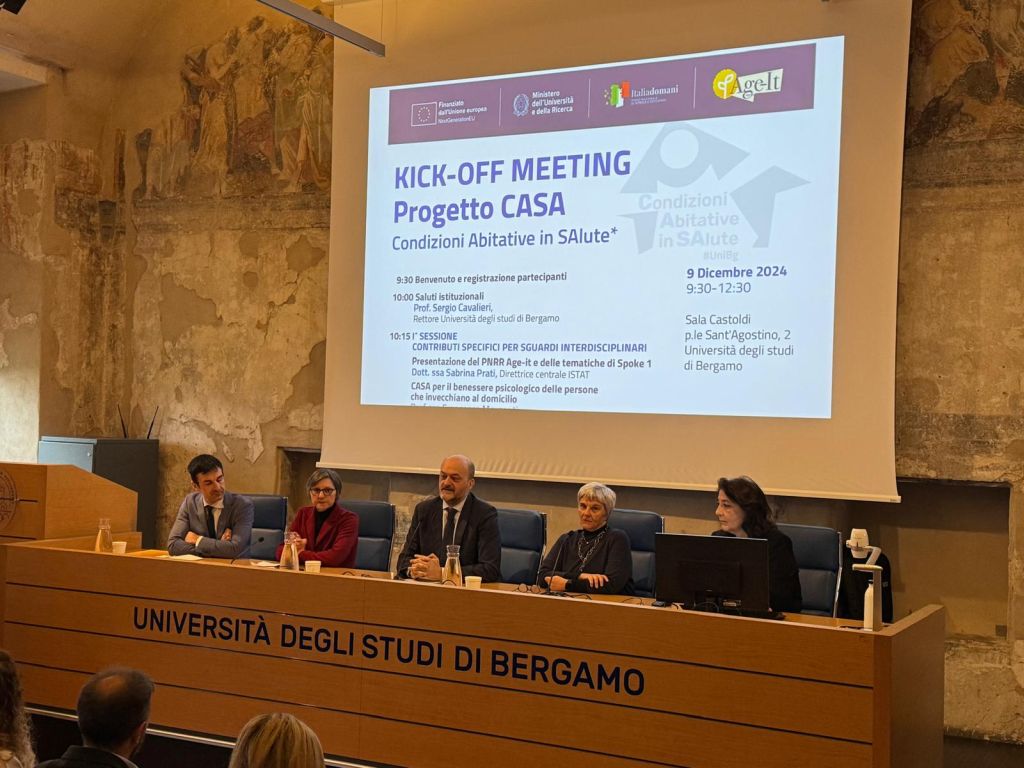BERGAMO (ITALPRESS) – In the Castoldi Lecture Hall of the University of Bergamo, the CASA project, “Aging in Cities-Medium: How Housing Conditions and Urban Spaces Can Reduce or Increase Opportunities for Longevity in SAlute,” was presented at the initiative of the CHL – Center For Healthy Longevity at the University of Bergamo, and funded under the Spoke 1 cascade call of the PNRR AGE-IT – Ageing Well in an Ageing Society. In Italy, most people over 65 live in medium-sized cities and, barring situations of non-self-sufficiency, continue to age in their own homes, a phenomenon known as Ageing in Place. Therefore, housing and urban conditions play a crucial role in determining the quality of life and health of older people, affecting their opportunities for healthy longevity. It is in this context that the CASA project is set, which aims to analyze how the characteristics of the housing, urban and social space of average Italian cities can affect aging trajectories. Through the analysis of sociodemographic data, of individual motivations for choosing living places, and by introducing the spatial analysis of the city of Bergamo, taken as a case study as a representative city of medium-sized Italian urban realities, the project aims to define an analytical-interpretive model of Ageing in Place that can also be applied to other urban contexts. To pursue this goal, the study involves faculty and researchers within the CHL from three departments of the University of Bergamo: Human and Social Sciences, Engineering and Applied Sciences, and Economics. The funding represents an extraordinary opportunity for the University of Bergamo, allowing it to join the AGE-IT PNRR partnership and strengthening its role in the national longevity research landscape. In addition, it confirms the University’s commitment to the theme of aging, already demonstrated with the City of Bergamo through its membership in the Cities of Longevity international network, promoted by the National Innovation Centre Ageing (NICA) in Newcastle, and with the Memorandum of Understanding signed at the birth of the CHL together with institutions in the Lombardy and Bergamo areas. Institutional greetings from the Rector of the University of Bergamo Sergio Cavalieri, and the Mayor of the City of Bergamo Elena Carnevali, were followed by specific and interdisciplinary contributions from Sabrina Prati – ISTAT, for the presentation of the AGE-IT PNRR and related issues pertaining to Spoke 1, Francesca Morganti, director of the CHL, on the value of the project for the Research Center. Emanuele Garda, from the Department of Engineering and Applied Sciences, and Giuliano Masiero and Michela Cameletti, from the Department of Economic Sciences, went into the heart of the project, presenting it and elaborating on the actions it envisions. Speakers at the panel discussion entitled “Ageing in Place” included Councillor for Social Policies, Longevity, Health, Sports of the Municipality of Bergamo Marcella Messina; Councillor for Urban Regeneration, Urban Planning, Private Construction, Heritage of the Municipality of Bergamo Francesco Valesini; Councillor for Housing Policy, Participation, Neighborhood Networks and Legal Affairs Claudia Lenzini; ISTAT Central Director, responsible for the enhancement of official demographic and social statistics, Sabrina Prati; and CHL -Center for Healthy Longevity director Francesca Morganti. Emphasizes Francesca Morganti, director of the CHL “This project has a highly strategic value for us and represents one of the first projects of the CHL-Center for Healthy Longevity because it goes well to position the center in the national panorama and especially within a multidisciplinary partnership that is already widely exploring the determinants of healthy longevity. It equally represents the beginning of the interdepartmental collaboration of our UniBg scholars, without which the CASA project would have no chance whatsoever of success. Finally, it is evidence of the commitment CHL has had since its inception: that of working by looking at its own city and how to make the citizens of Bergamo more aware of their near-future aging trajectories.”(ITALPRESS).
Photo: University of Bergamo Press Office

